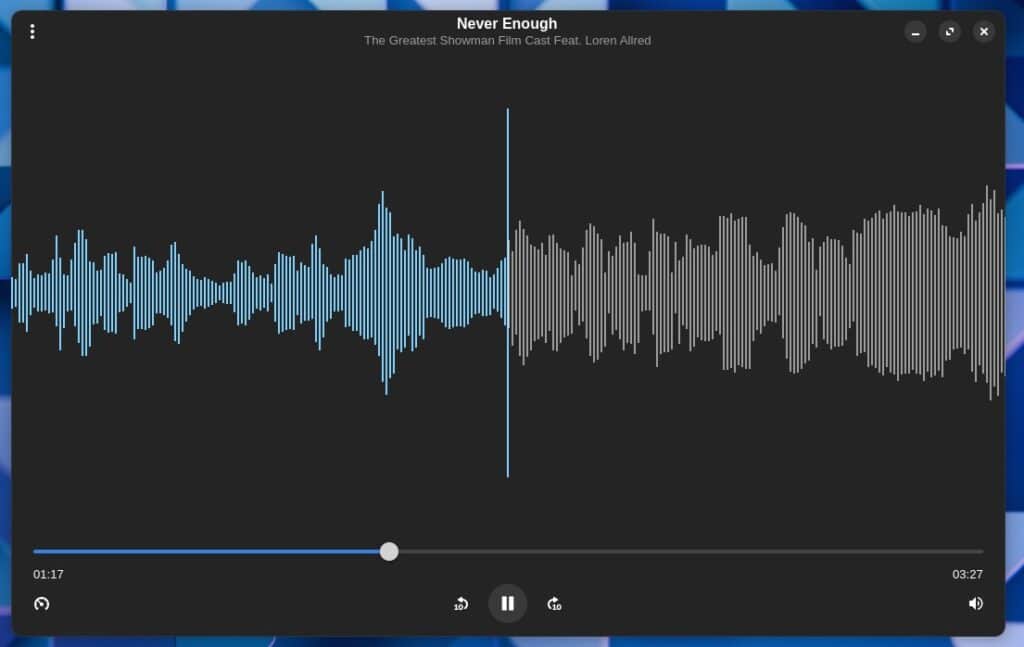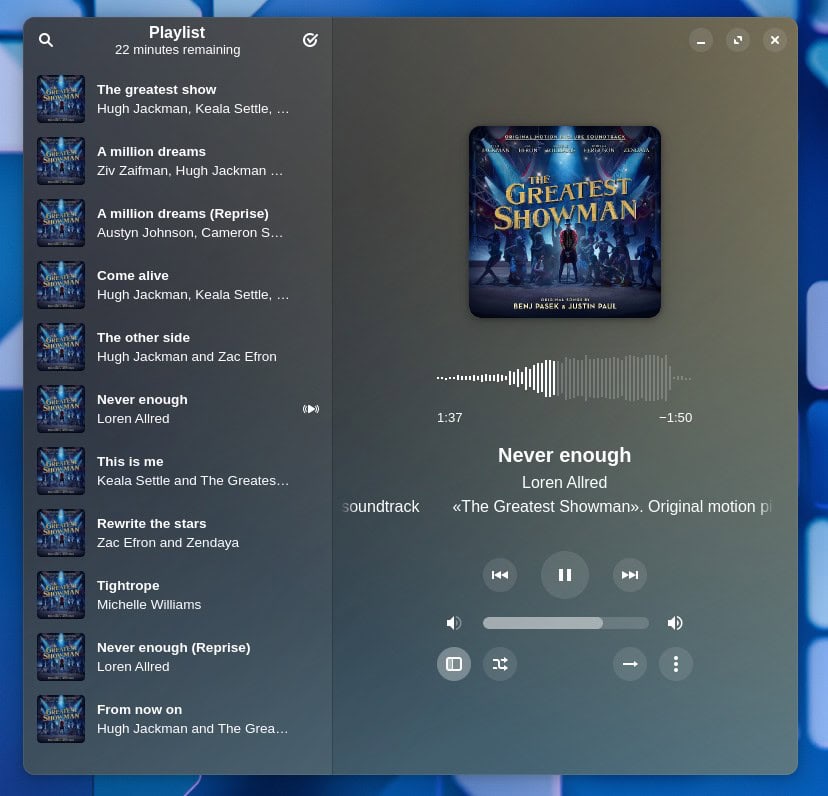The decisions made by GNOME developers no longer surprise me. I’ve come to accept that everything in this desktop environment happens differently—though, unfortunately, not in the positive “different” familiar to us from one other operating system. Here’s yet another example of that.
Let me start by saying this loud and clear: this article doesn’t question the quality of the Decibels audio player. I’m convinced it’s a great piece of software. Instead, this is about something else—the GNOME developers’ decision to choose it (among a wide range of similar alternatives) as one of the desktop environment’s core apps.
And so, a few days ago, Decibels (an audio player written in TypeScript) was moved from the GNOME Incubator (a project to help new applications and libraries become official GNOME ones) to the core apps of the desktop environment. What does this mean? When you install a vanilla GNOME, Decibels will now be included as part of the standard application suite.
Additionally, due to its updated status, the application will be rebranded from its current name, Decibels, to GNOME Audio Player. This aligns with naming conventions commonly followed by GNOME developers. For example, the Nautilus file manager is simply called Files, the Epiphany web browser is known as Web, and so on.
Since I wasn’t familiar with the app, I immediately headed to Flathub to install it. Excitedly, I launched the audio file, eager to experience GNOME’s new choice for audio playback. And then… this is what I was met with.

Hold on a second—did I accidentally open Audacity instead of the right app? Nope, that’s not it. I took a moment to check for some basic features you’d expect from an audio player: a library, track browser, tag editing (eventually), album arts, and so on. And guess what? None of those are here.
The app does one thing: it plays a single audio file while showing you the waveform. That’s it. Hoping to queue up multiple tracks? Whoa there, don’t get too ambitious.
Once again, the app’s Flathub page description is brief and to the point: “Shows the waveform of the track.” And yes, it does exactly that—no issues there. However, it’s far from acceptable for this solution to be considered a major component of GNOME, one of the two leading desktop environments (soon to become one of the three leading options in March).
The reason is crystal clear: Decibels lack even the basic features needed to serve as the default music player. And that’s not a flaw in the app—it’s simply designed to do exactly what it was meant to do.
Now, picture a new Linux user deciding to try GNOME for the first time or choosing a distribution that offers a vanilla GNOME experience. One of the first things they’ll likely do is test the multimedia capabilities. They double-click on an audio file, and… well, that’s what I’d call a disappointing introduction to Linux.
However, I hope that after the next versions of GNOME are released (when Decibels will debut), most distros will take the forward-thinking step of removing it from their GNOME implementations and replacing it with something most suitable as a default audio player – for the good of its users.
Honestly, no matter how much I try to understand the reasoning behind this decision from the GNOME developers, I just can’t seem to figure it out. The only explanation I can come up with is that the app is sticking to their sacred GNOME design guidelines—you know, all that GTK 4 and Libadwaita stuff.
But even in this niche, there are apps that may not boast a wide range of features but present the basics in an eye-catching, visually appealing way while adhering strictly also to those GNOME design guidelines. A perfect example of this is the Amberol music player.

What to say in conclusion? Once again, GNOME stays true to itself by offering yet another controversial solution for its users. But let’s be honest—who’s surprised at this point?
The days of having a persistent panel, a system tray, or using your desktop for more than just displaying wallpaper are long gone. Users gave up on that dream a while back. And every six months, they brace themselves for another round of extension incompatibilities just to bring back some semblance of normalcy.
What strikes me as particularly ironic is GNOME’s own Human Interface Guidelines, which proudly state, “People are at the heart of GNOME design.” With all due respect, if that’s the case, maybe I’m not considered “people.” Anyway. COSMIC is coming—perhaps it’ll help me feel human again.

its nothing but a audio player that allows you to play a file but you can still install whatever you want to manage your music. most distro's are going to include something else so it really does not matter. most people never use the default option or at least i never do and nobody was going to use this for there collection of music anyhow since its only there to play a file if nothing else is installed which would be rare.
GNOME is soon going to become the desktop for a select few, made for GTK/GNOME developers only.
KDE Plasma has been rock solid for me and has much more respect for their users. And of course COSMIC, while still not finished yet, looks to be modern GNOME but competently done and not a crippled macOS once they get it to a RC status.
The fact that 6 DEs came out of GNOME 3 and later (MATE, Cinnamon, LXQt, and Unity for GNOME 3, and Budgie moving away from GTK and COSIMC for GNOME 42 and the move to LibAdwaita) really shows some important GNOME developers need to think beyond themselves, which they still appear to be unable to do or refuse to do.
If you think libadwaita is bad, you think libcosmic is anything better? It looks terrible in other DEs.
You can literally say the same thing about LibAdwaita. It looks even WORSE in anything except for GNOME.
Also, who the heck is liking these comments and disliking mine!? GNOME developers and fanboys!? This is a desktop that actively breaks Linux for everybody else by not implementing Wayland protocols like server side window decorations, causing some applications like DaVinci Resolve to completely break on GNOME Wayland!
the server side decorations protocol is optional and still requires csd fallback. If you don't know what you are talking about don't comment at all.
Yes, it is optional, but that's because GNOME developers opposed it so much.
And supporting server side decorations are still better imo because it won't lead to broken apps like DaVinci Resolve on GNOME.
I'll never understand gnome people. Not only are they willing to live with all the weird design decisions, but they're often combative about it. I get that this isn't supposed to be more than what it is, but I question the necessity of such a limited thing earning a place among the few, the proud, the ever so humbly-named core gnome app selection. I'm guessing that rhythmbox will still be there, but nothing would surprise me.
In the interest of fairness, I'll admit that Plasma's default music and video apps aren't all that great either. I'd rather see Strawberry and VLC than Haruna and especially Dragon, though I get that those are probably overkill for most people.
Audio player, not music player/organizer/manager.
And the last time you reached for an audio player this limited was?
Totem. Decibels is replacing Totem.
Another company to show such disrespect to their users and customers is Microsoft. Quit using Gnome since 3.x for what they did. Remember Windows 8? Gnome 3 is the same and even worse and still being actively pushed as new normal.
I fully agree with you, Bobby. I might add another comparison: let the Gnome developers throw out Libre Office and let them embrace Mousepad as their core office app. I guess we must accept that there many people who are intelligent in a different way. It's just life – we must be compassionate for those of us who may be lacking in some areas and shine in some other areas.
i prefer distros with minimal installers and do not even want a office app or music app preinstalled since i usually never like or prefer what they think i may want to use.
Libreoffice has never been a core app of gnome or kde. Core apps are first party apps.
Lol, Mousepad is an Xfce app.
Well yes, but actually no. Number of users having music collected on the hard drive is going marginal. Being born in the early 90's and living through tapes and CD's, also having a large collection of both, yet I'm choosing Spotify and YouTube Music to listen to favourite music. On PC acutally it's more conveniet for me to be able to play that one track I've just downloaded because I want to use it in a video or something. Decibels will be perfect for this purpose.
Lmao dude cosmic is full of memory leaks and you think it's one of the three leading options and not XFCE which is fully featured and default in distros.
Cosmic is still Alpha, Gnome is considered mature…
what does cosmic have to do with XFCE, cant you read?
Gnome*
Another clickbait title with the right amount of lack of research.
It's an audio player not a music player. Amberol and Decibels serve different purposes. The article is filled with jabs at gnome but fails to engage with the actual topic.
Ideas for your next article: Image viewer falls flat when compared to image editing software
I don't know how many people listen to audio that's not music or podcasts, which they'd most likely be streaming. What "audio" are you going to use this for? I'm genuinely curious. I think people creating audio content will be using something more advanced, right? So really, what IS the usage scenario here? Possibly e-books?
Most people I know that produce audio content you Audacity.
You are just saying things with no base at this point. Decibels is not a new concept. For years the GNOME audio (not music) player has been totem which is worse than anything you can imagine for the job because it's a video player. Decibels is replacing totem. You would know that if you used GNOME but you don't ans just comment for the sake of commenting.
Does it really save so many resources compared to simply putting VLC in and that will play EVERYTHING, with simple interface options? This makes NO sense. I am using Gnome currently to test, and it is pathetic, trying to use Totem to play a video is STILL buggy when seeking a few times, it then hangs indefinitely. Basic h264 mp4.
So I agree it needs replacing – but why something without basic playlist support? It’s like everything in GNOME – a GUI-first approach, remember – forces you to learn convoluted CLI or gsettings commands. Which is goddamn hard with brain injury or other memory issues, I can tell you! In other words it appears to miss its target demographic.
🥱
Explain.